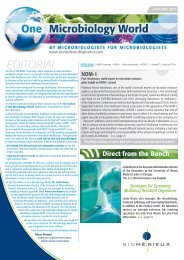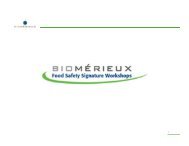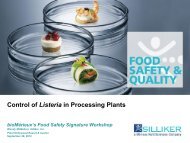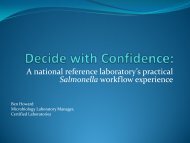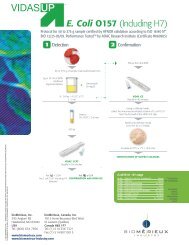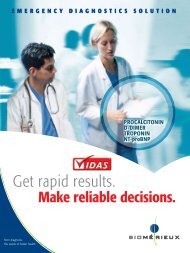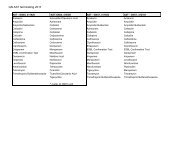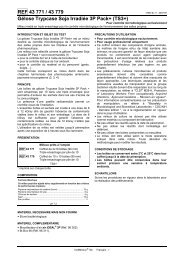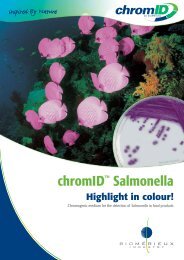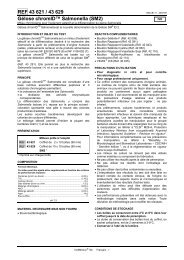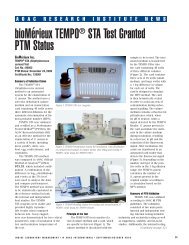BBI-029-08 Library Stats Sheet: Salmonella - bioMerieux
BBI-029-08 Library Stats Sheet: Salmonella - bioMerieux
BBI-029-08 Library Stats Sheet: Salmonella - bioMerieux
You also want an ePaper? Increase the reach of your titles
YUMPU automatically turns print PDFs into web optimized ePapers that Google loves.
<strong>Library</strong> <strong>Stats</strong> <strong>Sheet</strong>: <strong>Salmonella</strong> Not for Use in Diagnostic Procedures.<br />
DiversiLab Kit: <strong>Salmonella</strong> Kit (cat.# 270625)<br />
DiversiLab <strong>Library</strong> Name: DL <strong>Salmonella</strong> <strong>Library</strong><br />
Application: Characterization of <strong>Salmonella</strong> serotypes and strain-level discrimination among <strong>Salmonella</strong><br />
enterica isolates<br />
Reference Method: Serotyping<br />
<strong>Library</strong> Contents Overview<br />
Total Number of Samples represented: 313<br />
QC strains 16<br />
Cutoff for strain-type match: Indistinguishable<br />
O Antigen<br />
Serogroup<br />
B<br />
C1<br />
C2<br />
Serotype Entries<br />
Agona 4<br />
Brandenburg 3<br />
Derby 4<br />
Heidelberg 10<br />
I 4,[5],12:i:- 19<br />
Kiambu 2<br />
Paratyphi B 5<br />
Reading 3<br />
Saintpaul 4<br />
Sandiego 5<br />
Schwarzengrund 6<br />
Stanley 4<br />
Typhimurium 22<br />
Bareilly 6<br />
Braenderup 5<br />
Choleraesuis 4<br />
Hartford 4<br />
Infantis 7<br />
Mbandaka 10<br />
Montevideo 10<br />
Ohio 4<br />
Oranienburg 7<br />
Tennessee 4<br />
Thompson 8<br />
Virchow 2<br />
Blockley 2<br />
Hadar 11<br />
I 8,20:-:z6 7<br />
Litchfield 10<br />
Manhattan 2<br />
Muenchen 6<br />
Newport 12<br />
C3 Kentucky 9<br />
Berta 9<br />
Dublin 3<br />
D1<br />
Enteritidis<br />
Javiana<br />
12<br />
5<br />
Panama 2<br />
Typhi 4<br />
bioMérieux, Inc. · 100 Rodolphe Street · Durham, NC 27712 · (800) 682-2666 · www.biomerieux-usa.com/diversilab
Anatum 5<br />
E1<br />
Meleagridis<br />
Muenster<br />
4<br />
4<br />
Uganda 4<br />
E4 Senftenberg 5<br />
F Rubislaw 2<br />
G1<br />
Poona<br />
Worthington<br />
2<br />
5<br />
Cubana 3<br />
G2 Havana 2<br />
Mississippi 3<br />
K<br />
Cerro<br />
IIIa 18:z4,z32:-<br />
5<br />
4<br />
L Minnesota 2<br />
O Adelaide 2<br />
R Johannesburg 5<br />
Viewable Report Fields<br />
Genus Genus<br />
Species species<br />
Subspecies subspecies<br />
Strain ATCC # (when applicable)<br />
Class 1 serotype<br />
General Information:<br />
The complete <strong>Salmonella</strong> library is comprised of 313 entries: 309 <strong>Salmonella</strong> enterica subspecies<br />
enterica isolates and four <strong>Salmonella</strong> enterica subspecies arizonae isolates. In total 55 serotypes are<br />
represented, including the thirty most frequently isolated <strong>Salmonella</strong> serotypes from human sources<br />
reported to the CDC in 2005, as well as the thirty most frequently isolated serotypes from both clinical and<br />
non-clinical nonhuman sources reported to the CDC and NVSL in 2005 1 . The serotype associated with<br />
each isolate is provided in the Class 1 field. To view this information, select Class 1 as a viewable report<br />
field when generating your report.<br />
The entire <strong>Salmonella</strong> library is available for comparison. However, for ease of use the library has been<br />
divided into three separate data sets on the basis of O-antigen serogroups:<br />
1) The <strong>Salmonella</strong> serogroup B sub-library includes 91 isolates.<br />
2) The <strong>Salmonella</strong> serogroup C sub-library, including groups C1, C2 and C3 as noted above,<br />
consists of 130 isolates.<br />
3) The <strong>Salmonella</strong> serogroups D, E, F, G, K, L, O, and R sub-library is made up of the remaining<br />
92 isolates.<br />
For laboratories with antisera available for determining the O group, we recommend that this procedure<br />
be performed first in order to determine which sub-library to employ for comparison.<br />
In general, the libraries show clustering on the basis of the serotype as per the Kauffmann-White scheme.<br />
When comparing your samples to the DiversiLab <strong>Salmonella</strong> Libraries, it is best to use the Classification<br />
Report and the Top Match module. If the query sample exhibits a high percent similarity to a library entry,<br />
next view the electropherogram overlays to closely examine the samples.<br />
bioMérieux, Inc. · 100 Rodolphe Street · Durham, NC 27712 · (800) 682-2666 · www.biomerieux-usa.com/diversilab
© 20<strong>08</strong> bioMérieux, Inc. <strong>BBI</strong>-<strong>029</strong>-<strong>08</strong><br />
The top match shows indistinguishable fingerprint patterns of serotype Hartford to the library as 99%<br />
(Figure 1). However, it is important to view graph overlays as some serotype fingerprints can be different<br />
with >97% similarity (Figures 2 and 3).<br />
Figure 1: Top Match<br />
Figure 2. Montevideo vs Oranienburg<br />
Montevideo<br />
Oranienburg<br />
Note: Since over 2500 serotypes are recognized, it is possible that there are occurrences in which a rarely reported serotype not<br />
included here may exhibit a fingerprint indistinguishable from library samples.<br />
1. CDC. <strong>Salmonella</strong> Surveillance: Annual Summary, 2005. Atlanta, Georgia: U.S. Department of Health and Human Services,<br />
CDC, 2007.<br />
Note: The <strong>Library</strong> should be used as a guide.<br />
Figure 3. Typhimurium vs Infantis<br />
Typhimurium<br />
Infantis<br />
Denotes query samples<br />
Denotes library samples<br />
bioMérieux, Inc. · 100 Rodolphe Street · Durham, NC 27712 · (800) 682-2666 · www.biomerieux-usa.com/diversilab



